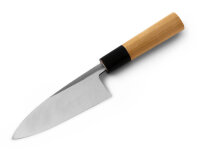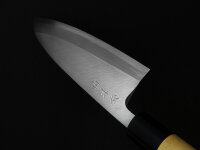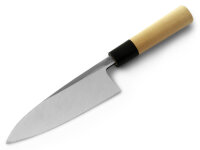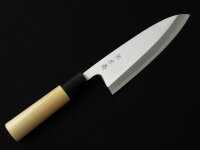
Deba Knives
The Deba Knife. Ideal for Cutting Fish and Meat
What is a Deba knife? A Deba is a sturdy Japanese knife with a strong spine and a robust blade. It's the perfect tool for splitting fish bones and small bones. With some skill, you can precisely fillet a fish with little effort. Especially the single-beveled Deba prevents the splintering of the cut material.
Only the highest-quality carbon steels are used for a premium Japanese Deba knife. Traditionally, the Deba knife is made with a single bevel. Despite its slightly heavier weight, it is well-balanced and comfortable to hold. The blade length ranges from 12 cm to 20 cm. Due to its blade thickness, the knife is heavier compared to the Santoku and is well-suited for slicing thin pieces of hard ingredients. A hand-forged Japanese Deba knife made through traditional craftsmanship is a tool for professionals. It not only adds prestige to the kitchen but also enables precise cutting techniques commonly found in upscale cuisine.
Proper Use of the Deba Knife
The Deba is also known as a Japanese cleaver, but it is by no means used for chopping with a swinging motion. This could unnecessarily damage the sharp edge. Instead, the Deba knife is used with a palm pressure when cutting through a fish. When dealing with larger bones, a small tap with the palm on the back of the blade is often sufficient. Additionally, always pay attention to the cutting surface; we recommend using a wooden cutting board. Ideally, choose a soft wood like Japanese Cypress, as it can help maintain the sharpness of the knives for longer.
Care Tips and Notes for Your Deba Chef's Knife
Japanese chef's knives are typically made from non-stainless carbon steels. Therefore, we recommend rinsing the kitchen knife with clear water after use and drying it. Knives should never be placed in the dishwasher. To care for the blade and the wooden handle, we recommend using a bit of camellia oil. Be sure to protect the blade in the knife drawer from contact with other kitchen knives.
For sharpening the knife, use Japanese water sharpening stones. If there are no visible damages to the blade's edge, you can restore the utility sharpness with a grit of 800 - 1,200. For honing and fine polishing, use a finer grit between 6,000 and 10,000. In our sharpening guide, you will find two different techniques to make sharpening easy.
On our YouTube channel, you will find a video tutorial on how Japanese masters sharpen knives on a Japanese waterstone.




